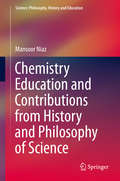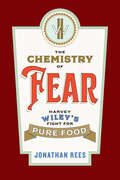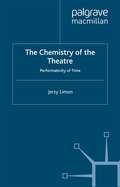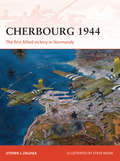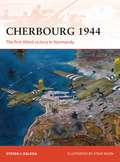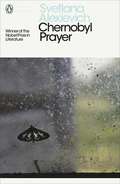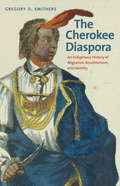- Table View
- List View
Chemically Imbalanced: Everyday Suffering, Medication, and Our Troubled Quest for Self-Mastery
by Joseph E. DavisEveryday suffering—those conditions or feelings brought on by trying circumstances that arise in everyone’s lives—is something that humans have grappled with for millennia. But the last decades have seen a drastic change in the way we approach it. In the past, a person going through a time of difficulty might keep a journal or see a therapist, but now the psychological has been replaced by the biological: instead of treating the heart, soul, and mind, we take a pill to treat the brain. Chemically Imbalanced is a field report on how ordinary people dealing with common problems explain their suffering, how they’re increasingly turning to the thin and mechanistic language of the “body/brain,” and what these encounters might tell us. Drawing on interviews with people dealing with struggles such as underperformance in school or work, grief after the end of a relationship, or disappointment with how their life is unfolding, Joseph E. Davis reveals the profound revolution in consciousness that is underway. We now see suffering as an imbalance in the brain that needs to be fixed, usually through chemical means. This has rippled into our social and cultural conversations, and it has affected how we, as a society, imagine ourselves and envision what constitutes a good life. Davis warns that what we envision as a neurological revolution, in which suffering is a mechanistic problem, has troubling and entrapping consequences. And he makes the case that by turning away from an interpretive, meaning-making view of ourselves, we thwart our chances to enrich our souls and learn important truths about ourselves and the social conditions under which we live.
Chemically Imbalanced: Everyday Suffering, Medication, and Our Troubled Quest for Self-Mastery
by Joseph E. DavisEveryday suffering—those conditions or feelings brought on by trying circumstances that arise in everyone’s lives—is something that humans have grappled with for millennia. But the last decades have seen a drastic change in the way we approach it. In the past, a person going through a time of difficulty might keep a journal or see a therapist, but now the psychological has been replaced by the biological: instead of treating the heart, soul, and mind, we take a pill to treat the brain. Chemically Imbalanced is a field report on how ordinary people dealing with common problems explain their suffering, how they’re increasingly turning to the thin and mechanistic language of the “body/brain,” and what these encounters might tell us. Drawing on interviews with people dealing with struggles such as underperformance in school or work, grief after the end of a relationship, or disappointment with how their life is unfolding, Joseph E. Davis reveals the profound revolution in consciousness that is underway. We now see suffering as an imbalance in the brain that needs to be fixed, usually through chemical means. This has rippled into our social and cultural conversations, and it has affected how we, as a society, imagine ourselves and envision what constitutes a good life. Davis warns that what we envision as a neurological revolution, in which suffering is a mechanistic problem, has troubling and entrapping consequences. And he makes the case that by turning away from an interpretive, meaning-making view of ourselves, we thwart our chances to enrich our souls and learn important truths about ourselves and the social conditions under which we live.
Chemically Imbalanced: Everyday Suffering, Medication, and Our Troubled Quest for Self-Mastery
by Joseph E. DavisEveryday suffering—those conditions or feelings brought on by trying circumstances that arise in everyone’s lives—is something that humans have grappled with for millennia. But the last decades have seen a drastic change in the way we approach it. In the past, a person going through a time of difficulty might keep a journal or see a therapist, but now the psychological has been replaced by the biological: instead of treating the heart, soul, and mind, we take a pill to treat the brain. Chemically Imbalanced is a field report on how ordinary people dealing with common problems explain their suffering, how they’re increasingly turning to the thin and mechanistic language of the “body/brain,” and what these encounters might tell us. Drawing on interviews with people dealing with struggles such as underperformance in school or work, grief after the end of a relationship, or disappointment with how their life is unfolding, Joseph E. Davis reveals the profound revolution in consciousness that is underway. We now see suffering as an imbalance in the brain that needs to be fixed, usually through chemical means. This has rippled into our social and cultural conversations, and it has affected how we, as a society, imagine ourselves and envision what constitutes a good life. Davis warns that what we envision as a neurological revolution, in which suffering is a mechanistic problem, has troubling and entrapping consequences. And he makes the case that by turning away from an interpretive, meaning-making view of ourselves, we thwart our chances to enrich our souls and learn important truths about ourselves and the social conditions under which we live.
Chemically Imbalanced: Everyday Suffering, Medication, and Our Troubled Quest for Self-Mastery
by Joseph E. DavisEveryday suffering—those conditions or feelings brought on by trying circumstances that arise in everyone’s lives—is something that humans have grappled with for millennia. But the last decades have seen a drastic change in the way we approach it. In the past, a person going through a time of difficulty might keep a journal or see a therapist, but now the psychological has been replaced by the biological: instead of treating the heart, soul, and mind, we take a pill to treat the brain. Chemically Imbalanced is a field report on how ordinary people dealing with common problems explain their suffering, how they’re increasingly turning to the thin and mechanistic language of the “body/brain,” and what these encounters might tell us. Drawing on interviews with people dealing with struggles such as underperformance in school or work, grief after the end of a relationship, or disappointment with how their life is unfolding, Joseph E. Davis reveals the profound revolution in consciousness that is underway. We now see suffering as an imbalance in the brain that needs to be fixed, usually through chemical means. This has rippled into our social and cultural conversations, and it has affected how we, as a society, imagine ourselves and envision what constitutes a good life. Davis warns that what we envision as a neurological revolution, in which suffering is a mechanistic problem, has troubling and entrapping consequences. And he makes the case that by turning away from an interpretive, meaning-making view of ourselves, we thwart our chances to enrich our souls and learn important truths about ourselves and the social conditions under which we live.
Chemistry and Chemists in Florence: From the Last of the Medici Family to the European Magnetic Resonance Center (SpringerBriefs in Molecular Science)
by Marco Fontani Mary Virginia Orna Mariagrazia CostaThis brief offers a novel vision of the city of Florence, tracing the development of chemistry via the biographies of its most illustrious chemists. It documents not only important scientific research that came from the hands of Galileo Galilei and the physicists who followed in his footsteps, but also the growth of new disciplines such as chemistry, pharmaceutical chemistry, and biochemistry. It recounts how, in the Middle Ages, chemistry began as an applied science that served to bolster the Florentine economy, particularly in the textile dyeing industry. Later, important scientific collections founded by the ruling Medici family served as the basis of renowned museums that now house priceless artifacts and instruments. Also described in this text are the chemists such as Hugo Schiff, Angelo Angeli, and Luigi Rolla, who were active over the course of the following century and a quarter. The authors tell the story of the evolution of the Royal University of Florence, which ultimately became the University of Florence. Of interest to historians and chemists, this tale is told through the lives and work of the principal actors in the university’s department of chemistry.
Chemistry Education and Contributions from History and Philosophy of Science (Science: Philosophy, History and Education)
by Mansoor NiazThis book explores the relationship between the content of chemistry education and the history and philosophy of science (HPS) framework that underlies such education. It discusses the need to present an image that reflects how chemistry developed and progresses. It proposes that chemistry should be taught the way it is practiced by chemists: as a human enterprise, at the interface of scientific practice and HPS. Finally, it sets out to convince teachers to go beyond the traditional classroom practice and explore new teaching strategies. The importance of HPS has been recognized for the science curriculum since the middle of the 20th century. The need for teaching chemistry within a historical context is not difficult to understand as HPS is not far below the surface in any science classroom. A review of the literature shows that the traditional chemistry classroom, curricula, and textbooks while dealing with concepts such as law, theory, model, explanation, hypothesis, observation, evidence and idealization, generally ignore elements of the history and philosophy of science. This book proposes that the conceptual understanding of chemistry requires knowledge and understanding of the history and philosophy of science.“Professor Niaz’s book is most welcome, coming at a time when there is an urgently felt need to upgrade the teaching of science. The book is a huge aid for adding to the usual way - presenting science as a series of mere facts - also the necessary mandate: to show how science is done, and how science, through its history and philosophy, is part of the cultural development of humanity.”Gerald Holton, Mallinckrodt Professor of Physics & Professor of History of Science, Harvard University“In this stimulating and sophisticated blend of history of chemistry, philosophy of science, and science pedagogy, Professor Mansoor Niaz has succeeded in offering a promising new approach to the teaching of fundamental ideas in chemistry. Historians and philosophers of chemistry --- and above all, chemistry teachers --- will find this book full of valuable and highly usable new ideas”Alan Rocke, Case Western Reserve University “This book artfully connects chemistry and chemistry education to the human context in which chemical science is practiced and the historical and philosophical background that illuminates that practice. Mansoor Niaz deftly weaves together historical episodes in the quest for scientific knowledge with the psychology of learning and philosophical reflections on the nature of scientific knowledge and method. The result is a compelling case for historically and philosophically informed science education. Highly recommended!”Harvey Siegel, University of Miami “Books that analyze the philosophy and history of science in Chemistry are quite rare. ‘Chemistry Education and Contributions from History and Philosophy of Science’ by Mansoor Niaz is one of the rare books on the history and philosophy of chemistry and their importance in teaching this science. The book goes through all the main concepts of chemistry, and analyzes the historical and philosophical developments as well as their reflections in textbooks.Closest to my heart is Chapter 6, which is devoted to the chemical bond, the glue that holds together all matter in our earth. The chapter emphasizes the revolutionary impact of the concept of the ‘covalent bond’ on the chemical community and the great novelty of the idea that was conceived 11 years before quantum mechanics was able to offer the mechanism of electron pairing and covalent bonding. The author goes then to describe the emergence of two rival theories that explained the nature of the chemical bond in terms of quantum mechanics; these are valence bond (VB) and molecular orbital (MO) theories. He emphasizes the importance of having rival theories and interpretations in science and its advancement. He further argues that this VB-MO rivalry is still alive and together the two conceptual frames serve as the tool kit for thinking and doing chemistry in creative manners. The author surveys chemistr
Chemistry in 17th-Century New England (SpringerBriefs in Molecular Science)
by Gary PattersonThis book explores the lively chemistry culture that arose during the 17th century in Colonial New England. This was chiefly due to the efforts of John Winthrop, Jr. who brought both chemical knowledge and the largest library of chemical books in the New World to Boston. He founded towns, such as Ipswich and New London, and industrial enterprises, such as salt works and ironworks, while also serving as the primary source of Paracelsian medicines, which led him to become the most famous physician in Colonial New England. Moreover, the book covers topics such as the founding of Harvard College, and the life and works of Cotton Mather, especially Magnalia Christi Americana, one of the most important vanity volumes in the history of scholarly publication.
The Chemistry of Fear: Harvey Wiley's Fight for Pure Food
by Jonathan ReesA fascinating examination of the controversial work of Harvey Wiley, the founder of the pure food movement and an early crusader against the use of additives and preservatives in food.Though trained as a medical doctor, chemist Harvey Wiley spent most of his professional life advocating for "pure food"—food free of both adulterants and preservatives. A strong proponent of the Pure Food and Drug Act of 1906, still the basis of food safety legislation in the United States, Wiley gained fame for what became known as the Poison Squad experiments—a series of tests in which, to learn more about the effects of various chemicals on the human body, Wiley's own employees at the Department of Agriculture agreed to consume food mixed with significant amounts of various additives, including borax, saltpeter, copper sulfate, sulfuric acid, and formaldehyde. One hundred years later, Wiley's influence lives on in many of our current popular ideas about food: that the wrong food can kill you; that the right food can extend your life; that additives are unnatural; and that unnatural food is unhealthy food. Eating—the process of taking something external in the world and putting it inside of you—has always been an intimate act, but it was Harvey Wiley who first turned it into a matter of life or death.In The Chemistry of Fear, Jonathan Rees examines Wiley's many—and varied—conflicts and clashes over food safety, including the adulteration of honey and the addition of caffeine to Coca-Cola, formaldehyde to milk, and alum to baking powder. Although Wiley is often depicted as an unwavering champion of the consumer's interest, Rees argues that his critics rightfully questioned some of his motivations, as well as the conclusions that he drew from his most important scientific work. And although Wiley's fame and popularity gave him enormous influence, Rees reveals that his impact on what Americans eat depends more upon fear than it does upon the quality of his research. Exploring in detail the battles Wiley picked over the way various foods and drinks were made and marketed, The Chemistry of Fear touches upon every stage of his career as a pure food advocate. From his initial work in Washington researching food adulteration, through the long interval at the end of his life when he worked for Good Housekeeping, Wiley often wrote about the people who prevented him from making the pure food law as effective as he thought it should have been. This engaging book will interest anyone who's curious about the pitfalls that eaters faced at the turn of the twentieth century.
The Chemistry of Fear: Harvey Wiley's Fight for Pure Food
by Jonathan ReesA fascinating examination of the controversial work of Harvey Wiley, the founder of the pure food movement and an early crusader against the use of additives and preservatives in food.Though trained as a medical doctor, chemist Harvey Wiley spent most of his professional life advocating for "pure food"—food free of both adulterants and preservatives. A strong proponent of the Pure Food and Drug Act of 1906, still the basis of food safety legislation in the United States, Wiley gained fame for what became known as the Poison Squad experiments—a series of tests in which, to learn more about the effects of various chemicals on the human body, Wiley's own employees at the Department of Agriculture agreed to consume food mixed with significant amounts of various additives, including borax, saltpeter, copper sulfate, sulfuric acid, and formaldehyde. One hundred years later, Wiley's influence lives on in many of our current popular ideas about food: that the wrong food can kill you; that the right food can extend your life; that additives are unnatural; and that unnatural food is unhealthy food. Eating—the process of taking something external in the world and putting it inside of you—has always been an intimate act, but it was Harvey Wiley who first turned it into a matter of life or death.In The Chemistry of Fear, Jonathan Rees examines Wiley's many—and varied—conflicts and clashes over food safety, including the adulteration of honey and the addition of caffeine to Coca-Cola, formaldehyde to milk, and alum to baking powder. Although Wiley is often depicted as an unwavering champion of the consumer's interest, Rees argues that his critics rightfully questioned some of his motivations, as well as the conclusions that he drew from his most important scientific work. And although Wiley's fame and popularity gave him enormous influence, Rees reveals that his impact on what Americans eat depends more upon fear than it does upon the quality of his research. Exploring in detail the battles Wiley picked over the way various foods and drinks were made and marketed, The Chemistry of Fear touches upon every stage of his career as a pure food advocate. From his initial work in Washington researching food adulteration, through the long interval at the end of his life when he worked for Good Housekeeping, Wiley often wrote about the people who prevented him from making the pure food law as effective as he thought it should have been. This engaging book will interest anyone who's curious about the pitfalls that eaters faced at the turn of the twentieth century.
The Chemistry of the Theatre: Performativity of Time
by Jerzy LimonThis innovative, theoretical work focuses on temporal issues in theatre and the 'chemistry' of theatre - the ways in which a variety of factors in performance combine to make up what we call 'theatre'. Discussing a range of canonical plays, from Shakespeare to Beckett, the book makes a unique contribution to theatre and performance studies.
Chemistry, Pharmacy and Revolution in France, 1777-1809
by Jonathan SimonThis book explores the history of pharmacy in France and its relationship to the discipline of chemistry as it emerged at the beginning of the nineteenth century. It argues that an appreciation of the history of pharmacy is essential to a full understanding of the constitution of modern science, in particular the discipline of chemistry. As such, it provides a novel interpretation of the chemical revolution (c.1770-1789) that will, no doubt, generate much debate on the place of the chemical arts in this story, a question that has hitherto lacked sufficient scholarly reflection. Furthermore, the book situates this analysis within the broader context of the French Revolution, arguing that an intimate and direct link can be drawn between the political upheavals and our vision of the chemical revolution. The story of the chemical revolution has usually been told by focusing on the small group of French chemists who championed Lavoisier's oxygen theory, or else his opponents. Such a perspective emphasises competing theories and interpretations of critical experiments, but neglects the challenging issue of who could be understood as practising chemistry in the eighteenth century. In contrast, this study traces the tradition of pharmacy as a professional pursuit that relied on chemical techniques to prepare medicines, and shows how one of the central elements of the chemical revolution was the more or less conscious disassociation of the new chemistry from this ancient chemical art.
Chemistry, Pharmacy and Revolution in France, 1777-1809
by Jonathan SimonThis book explores the history of pharmacy in France and its relationship to the discipline of chemistry as it emerged at the beginning of the nineteenth century. It argues that an appreciation of the history of pharmacy is essential to a full understanding of the constitution of modern science, in particular the discipline of chemistry. As such, it provides a novel interpretation of the chemical revolution (c.1770-1789) that will, no doubt, generate much debate on the place of the chemical arts in this story, a question that has hitherto lacked sufficient scholarly reflection. Furthermore, the book situates this analysis within the broader context of the French Revolution, arguing that an intimate and direct link can be drawn between the political upheavals and our vision of the chemical revolution. The story of the chemical revolution has usually been told by focusing on the small group of French chemists who championed Lavoisier's oxygen theory, or else his opponents. Such a perspective emphasises competing theories and interpretations of critical experiments, but neglects the challenging issue of who could be understood as practising chemistry in the eighteenth century. In contrast, this study traces the tradition of pharmacy as a professional pursuit that relied on chemical techniques to prepare medicines, and shows how one of the central elements of the chemical revolution was the more or less conscious disassociation of the new chemistry from this ancient chemical art.
Cherbourg 1944: The first Allied victory in Normandy (Campaign)
by Steven J. Zaloga Mr Steve NoonSteven Zaloga offers up a rigorous and absorbing study of the first major Allied operation in Normandy after the D-Day landings – the capture of Cherbourg. Blending expert analysis, specially commissioned artwork and illustrative maps, this book tells the story of the bitter struggle to capture this vital point. Cherbourg was recognized by both the German and Allied High commands as crucial to the Allied foothold in Normandy – it was the nearest major port and was desperately needed by the Allies for major logistical operations to support their forces on long stretches of open beach. Hitler, on the other hand, declared Cherbourg to be a 'Festung' (fortress), a designation everyone knew to mean that its defenders were to fight to the last man. After a grueling struggle that involved several distinct tactical phases to overcome the different elements of Cherbourg's defence, the campaign resulted in a bittersweet Allied victory, the drama and significance of which are explained in full in this work.
Cherbourg 1944: The first Allied victory in Normandy (Campaign)
by Steven J. Zaloga Steve NoonSteven Zaloga offers up a rigorous and absorbing study of the first major Allied operation in Normandy after the D-Day landings – the capture of Cherbourg. Blending expert analysis, specially commissioned artwork and illustrative maps, this book tells the story of the bitter struggle to capture this vital point. Cherbourg was recognized by both the German and Allied High commands as crucial to the Allied foothold in Normandy – it was the nearest major port and was desperately needed by the Allies for major logistical operations to support their forces on long stretches of open beach. Hitler, on the other hand, declared Cherbourg to be a 'Festung' (fortress), a designation everyone knew to mean that its defenders were to fight to the last man. After a grueling struggle that involved several distinct tactical phases to overcome the different elements of Cherbourg's defence, the campaign resulted in a bittersweet Allied victory, the drama and significance of which are explained in full in this work.
The Cherished Five in Sikh History
by Louis E. FenechOn the 30th of March, 1699, the Sikh Guru Gobind Singh called together a special assembly at the Keshgarh Fort at Anandpur. Following the morning devotions, the Guru asked for a volunteer, saying, "The entire sangat is very dear to me; but is there a devoted Sikh who will give his head to me here and now? A need has arisen at this moment which calls for a head." One man arose and followed the Guru out of the room. When the Guru returned to the assembly with a bloodied sword, he asked for another volunteer. Another man followed. This was repeated three more times, until at last the Guru emerged with a clean sword and all five men alive and well. Those five volunteers would become the first disciples of the Khalsa, the martial community within the Sikh religion, and would come to be known as the Panj Piare, or the Cherished Five. Despite the centrality of this group to modern Sikhism, scholarship on the Panj Piare has remained sparse. Louis Fenech's new book examines the Khalsa and the role that the the Panj Piare have had in the development of the Sikh faith over the past three centuries.
The Cherished Five in Sikh History
by Louis E. FenechOn the 30th of March, 1699, the Sikh Guru Gobind Singh called together a special assembly at the Keshgarh Fort at Anandpur. Following the morning devotions, the Guru asked for a volunteer, saying, "The entire sangat is very dear to me; but is there a devoted Sikh who will give his head to me here and now? A need has arisen at this moment which calls for a head." One man arose and followed the Guru out of the room. When the Guru returned to the assembly with a bloodied sword, he asked for another volunteer. Another man followed. This was repeated three more times, until at last the Guru emerged with a clean sword and all five men alive and well. Those five volunteers would become the first disciples of the Khalsa, the martial community within the Sikh religion, and would come to be known as the Panj Piare, or the Cherished Five. Despite the centrality of this group to modern Sikhism, scholarship on the Panj Piare has remained sparse. Louis Fenech's new book examines the Khalsa and the role that the the Panj Piare have had in the development of the Sikh faith over the past three centuries.
Chernobyl: The Devastation, Destruction and Consequences of the World's Worst Radiation Accident
by Ian FitzgeraldIn the early hours of the morning of 26 April 1986, the nuclear reactor at the Chernobyl power plant in Ukraine exploded, unleashing a storm of radioactive material into the atmosphere and contaminating most of Europe with its fallout. It was a disaster on an unprecedented scale.This is a story of hubris, heroism and tragedy as engineers, firefighters, doctors and government officials all worked to contain the fiasco.In this volume, Ian Fitzgerald reveals the details of how the accident occurred, the desperate response to the situation and the investigation and recriminations that followed. He asks what lessons can be learned - and what, if anything, we are doing to make sure they can never happen again.
Chernobyl: History of a Tragedy
by Serhii Plokhy'A nuclear nightmare told minute by minute ... extraordinary ... powerful storytelling. Plokhy is a master' The TimesThe gripping story of the Chernobyl nuclear disaster, from an acclaimed historian and writerOn the morning of 26 April 1986 Europe witnessed the worst nuclear disaster in history: the explosion of a reactor at the Chernobyl nuclear power plant in Soviet Ukraine. The outburst put the world on the brink of nuclear annihilation. In the end, less than five percent of the reactor's fuel escaped, but that was enough to contaminate over half of Europe with radioactive fallout. In Chernobyl, Serhii Plokhy recreates these events in all of their drama, telling the stories of the firefighters, scientists, engineers, workers, soldiers, and policemen who found themselves caught in a nuclear Armageddon and succeeded in doing the seemingly impossible: extinguishing the nuclear inferno and putting the reactor to sleep. While it is clear that the immediate cause of the accident was a turbine test gone wrong, Plokhy shows how the deeper roots of Chernobyl lay in the nature of the Soviet political system and the flaws of its nuclear industry. A little more than five years later, the Soviet Union would fall apart, destroyed from within by its unsustainable communist ideology and the dysfunctional managerial and economic systems laid bare in the wake of the disaster.A poignant, fast paced account of the drama of heroes, perpetrators, and victims, Chernobyl is the definitive history of the world's worst nuclear disaster.
Chernobyl: Crime without Punishment
by Alla YaroshinskayaLong before the tragedy of the 2011 nuclear disasters in Japan, the nuclear reactor at Chernobyl experienced an explosion, meltdown, fire, and massive release of radioactivity. Twenty-five years later, we still know very little about the event and its aftermath. Few of the professional papers describing the aftereffects of the disaster have been translated from Russian into English or distributed in the West. This is now remedied, with the publication of this definitive volume, based on original sources, and originally published in Russian. Alla A. Yaroshinskaya describes the human side of the disaster, with firsthand accounts by those who lived through the world's worst public health crisis. Chernobyl: Crime without Punishment is a unique account of events by a reporter who defied the Soviet bureaucracy. The author presents an accurate historical record, with quotations from all the major players in the Chernobyl drama. It also provides unique insight into the final stages of Soviet communism. Yaroshinskaya describes actions after the disaster: how authorities built a new city for Chernobyl residents but placed it in a highly polluted area. She also details the actions of the nuclear lobby inside and outside the former Soviet Union. Bringing the book into the twenty-first century, the author reviews the latest medical data on Chernobyl people's health from the affected countries and from independent investigations; and states why there has been no trial of top officials who covered up Chernobyl and its disastrous consequences.
Chernobyl: Crime without Punishment
by Alla A. YaroshinskayaLong before the tragedy of the 2011 nuclear disasters in Japan, the nuclear reactor at Chernobyl experienced an explosion, meltdown, fire, and massive release of radioactivity. Twenty-five years later, we still know very little about the event and its aftermath. Few of the professional papers describing the aftereffects of the disaster have been translated from Russian into English or distributed in the West. This is now remedied, with the publication of this definitive volume, based on original sources, and originally published in Russian. Alla A. Yaroshinskaya describes the human side of the disaster, with firsthand accounts by those who lived through the world's worst public health crisis. Chernobyl: Crime without Punishment is a unique account of events by a reporter who defied the Soviet bureaucracy. The author presents an accurate historical record, with quotations from all the major players in the Chernobyl drama. It also provides unique insight into the final stages of Soviet communism. Yaroshinskaya describes actions after the disaster: how authorities built a new city for Chernobyl residents but placed it in a highly polluted area. She also details the actions of the nuclear lobby inside and outside the former Soviet Union. Bringing the book into the twenty-first century, the author reviews the latest medical data on Chernobyl people's health from the affected countries and from independent investigations; and states why there has been no trial of top officials who covered up Chernobyl and its disastrous consequences.
The Chernobyl Effect: Antinuclear Protests and the Molding of Polish Democracy, 1986–1990 (Protest, Culture & Society #32)
by Kacper Szulecki Tomasz Borewicz Janusz WaluszkoThe 1986 Chernobyl catastrophe was not only a human and ecological disaster, but also a political-ideological one, severely discrediting Soviet governance and galvanizing dissidents in the Eastern Bloc. In the case of Poland, what began as isolated protests against the Soviet nuclear site grew to encompass domestic nuclear projects in general, and in the process spread across the country and attracted new segments of society. This innovative study, combining scholarly analysis with oral histories and other accounts from participants, traces the growth and development of the Polish anti-nuclear movement, showing how it exemplified the broader generational and cultural changes in the nation’s opposition movements during the waning days of the state socialist era.
The Chernobyl Effect: Antinuclear Protests and the Molding of Polish Democracy, 1986–1990 (Protest, Culture & Society #32)
by Kacper Szulecki Tomasz Borewicz Janusz WaluszkoThe 1986 Chernobyl catastrophe was not only a human and ecological disaster, but also a political-ideological one, severely discrediting Soviet governance and galvanizing dissidents in the Eastern Bloc. In the case of Poland, what began as isolated protests against the Soviet nuclear site grew to encompass domestic nuclear projects in general, and in the process spread across the country and attracted new segments of society. This innovative study, combining scholarly analysis with oral histories and other accounts from participants, traces the growth and development of the Polish anti-nuclear movement, showing how it exemplified the broader generational and cultural changes in the nation’s opposition movements during the waning days of the state socialist era.
Chernobyl Prayer: A Chronicle of the Future
by Svetlana Alexievich Anna Gunin Arch TaitA startling history of the Chernobyl disaster by Svetlana Alexievich, the winner of the Nobel prize in literature 2015 On 26 April 1986, at 1.23am, a series of explosions shook the Chernobyl nuclear reactor. Flames lit up the sky and radiation escaped to contaminate the land and poison the people for years to come. While officials tried to hush up the accident, Svetlana Alexievich spent years collecting testimonies from survivors - clean-up workers, residents, firefighters, resettlers, widows, orphans - crafting their voices into a haunting oral history of fear, anger and uncertainty, but also dark humour and love. A chronicle of the past and a warning for our nuclear future, Chernobyl Prayer shows what it is like to bear witness, and remember in a world that wants you to forget.
Chernobyl Roulette: A War Story
by Serhii Plokhy'A necessary book – and I can think of no writer better qualified to write it' Cal Flyn What if Chernobyl was just the beginning?The acclaimed winner of the Baillie Gifford Prize returns to Chernobyl to tell the gripping story of thirty-five days of warOn 24 February 2022, the first day of Russia’s full-scale invasion of Ukraine, armoured vehicles approached the Chernobyl nuclear power plant in northern Ukraine. It was the most direct way for them to reach the capital - and an extraordinarily reckless plan after the disaster that had taken place there three decades earlier. Russian occupation of the plant had begun. It would last thirty-five days.Closely reported and narrated from multiple perspectives, this is the story of the Ukrainians who were held hostage and worked shifts for weeks instead of days to spare the world a new nuclear accident. We meet Valentyn Heiko, the foreman who had also been there for the clean-up of the Chernobyl accident in 1986 and turned sixty during the occupation; plant workers who found a way to celebrate International Women’s Day despite all odds; Russian officers who had no knowledge of nuclear reactors; and four stalkers who were caught in the middle and stood in for the overworked cook.Gripping and unforgettable, Chernobyl Roulette sounds the alarm about the dangers of nuclear sites in an unprecedented time, when plant workers are left to fight on their own while the world holds its breath. In a book that reads like a thriller, Serhii Plokhy tells a remarkable story about human nature, uncertainty and courage.
The Cherokee Diaspora: An Indigenous History of Migration, Resettlement, and Identity (The Lamar Series in Western History)
by Gregory D. SmithersThe Cherokee are one of the largest Native American tribes in the United States, with more than three hundred thousand people across the country claiming tribal membership and nearly one million people internationally professing to have at least one Cherokee Indian ancestor. In this revealing history of Cherokee migration and resettlement, Gregory Smithers uncovers the origins of the Cherokee diaspora and explores how communities and individuals have negotiated their Cherokee identities, even when geographically removed from the Cherokee Nation headquartered in Tahlequah, Oklahoma. Beginning in the eighteenth century, the author transports the reader back in time to tell the poignant story of the Cherokee people migrating throughout North America, including their forced exile along the infamous Trail of Tears (1838–39). Smithers tells a remarkable story of courage, cultural innovation, and resilience, exploring the importance of migration and removal, land and tradition, culture and language in defining what it has meant to be Cherokee for a widely scattered people.


